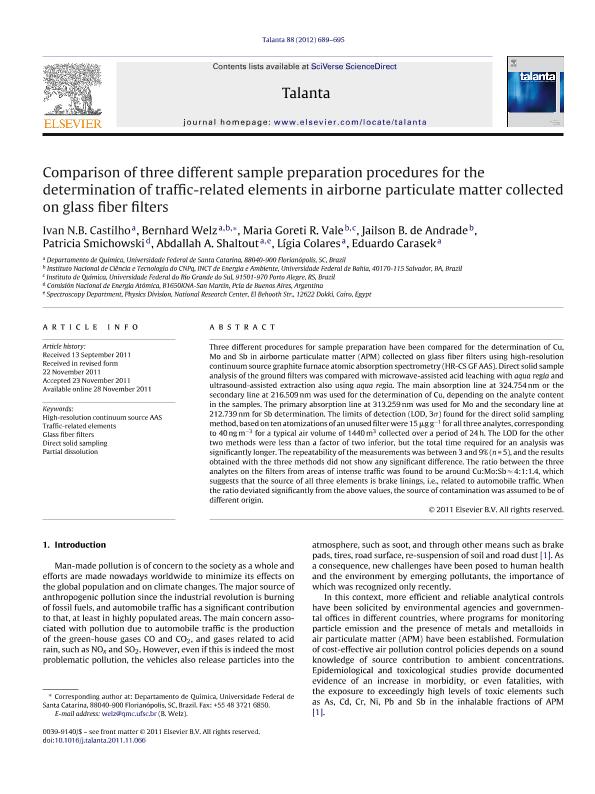Mostrar el registro sencillo del ítem
dc.contributor.author
Castilho, Ivan N. B.
dc.contributor.author
Welz, Bernhard
dc.contributor.author
Vale, Maria Goreti R.
dc.contributor.author
De Andrade, Jailson B.
dc.contributor.author
Smichowski, Patricia Nora

dc.contributor.author
Shaltout, Abdallah A.
dc.contributor.author
Colares, Lígia
dc.contributor.author
Carasek, Eduardo
dc.date.available
2023-04-19T13:08:42Z
dc.date.issued
2012-01
dc.identifier.citation
Castilho, Ivan N. B.; Welz, Bernhard; Vale, Maria Goreti R.; De Andrade, Jailson B.; Smichowski, Patricia Nora; et al.; Comparison of three different sample preparation procedures for the determination of traffic-related elements in airborne particulate matter collected on glass fiber filters; Elsevier Science; Talanta; 88; 1-2012; 689-695
dc.identifier.issn
0039-9140
dc.identifier.uri
http://hdl.handle.net/11336/194510
dc.description.abstract
Three different procedures for sample preparation have been compared for the determination of Cu, Mo and Sb in airborne particulate matter (APM) collected on glass fiber filters using high-resolution continuum source graphite furnace atomic absorption spectrometry (HR-CS GF AAS). Direct solid sample analysis of the ground filters was compared with microwave-assisted acid leaching with aqua regia and ultrasound-assisted extraction also using aqua regia. The main absorption line at 324.754 nm or the secondary line at 216.509 nm was used for the determination of Cu, depending on the analyte content in the samples. The primary absorption line at 313.259 nm was used for Mo and the secondary line at 212.739 nm for Sb determination. The limits of detection (LOD, 3σ) found for the direct solid sampling method, based on ten atomizations of an unused filter were 15 μg g-1 for all three analytes, corresponding to 40 ng m-3 for a typical air volume of 1440 m 3 collected over a period of 24 h. The LOD for the other two methods were less than a factor of two inferior, but the total time required for an analysis was significantly longer. The repeatability of the measurements was between 3 and 9% (n = 5), and the results obtained with the three methods did not show any significant difference. The ratio between the three analytes on the filters from areas of intense traffic was found to be around Cu:Mo:Sb ≈ 4:1:1.4, which suggests that the source of all three elements is brake linings, i.e., related to automobile traffic. When the ratio deviated significantly from the above values, the source of contamination was assumed to be of different origin.
dc.format
application/pdf
dc.language.iso
eng
dc.publisher
Elsevier Science

dc.rights
info:eu-repo/semantics/openAccess
dc.rights.uri
https://creativecommons.org/licenses/by-nc-sa/2.5/ar/
dc.subject
DIRECT SOLID SAMPLING
dc.subject
GLASS FIBER FILTERS
dc.subject
HIGH-RESOLUTION CONTINUUM SOURCE AAS
dc.subject
PARTIAL DISSOLUTION
dc.subject
TRAFFIC-RELATED ELEMENTS
dc.subject.classification
Química Analítica

dc.subject.classification
Ciencias Químicas

dc.subject.classification
CIENCIAS NATURALES Y EXACTAS

dc.title
Comparison of three different sample preparation procedures for the determination of traffic-related elements in airborne particulate matter collected on glass fiber filters
dc.type
info:eu-repo/semantics/article
dc.type
info:ar-repo/semantics/artículo
dc.type
info:eu-repo/semantics/publishedVersion
dc.date.updated
2023-04-18T13:14:31Z
dc.journal.volume
88
dc.journal.pagination
689-695
dc.journal.pais
Países Bajos

dc.journal.ciudad
Amsterdam
dc.description.fil
Fil: Castilho, Ivan N. B.. Universidade Federal de Santa Catarina; Brasil
dc.description.fil
Fil: Welz, Bernhard. Universidade Federal de Santa Catarina; Brasil. Universidade Federal da Bahia; Brasil
dc.description.fil
Fil: Vale, Maria Goreti R.. Universidade Federal da Bahia; Brasil. Universidade Federal do Rio de Janeiro; Brasil
dc.description.fil
Fil: De Andrade, Jailson B.. Universidade Federal da Bahia; Brasil
dc.description.fil
Fil: Smichowski, Patricia Nora. Comisión Nacional de Energía Atómica; Argentina. Consejo Nacional de Investigaciones Científicas y Técnicas; Argentina
dc.description.fil
Fil: Shaltout, Abdallah A.. Universidade Federal de Santa Catarina; Brasil
dc.description.fil
Fil: Colares, Lígia. Universidade Federal de Santa Catarina; Brasil
dc.description.fil
Fil: Carasek, Eduardo. Universidade Federal de Santa Catarina; Brasil
dc.journal.title
Talanta

dc.relation.alternativeid
info:eu-repo/semantics/altIdentifier/url/https://www.sciencedirect.com/science/article/pii/S0039914011010484
dc.relation.alternativeid
info:eu-repo/semantics/altIdentifier/doi/http://dx.doi.org/10.1016/j.talanta.2011.11.066
Archivos asociados
